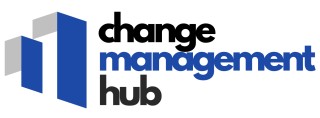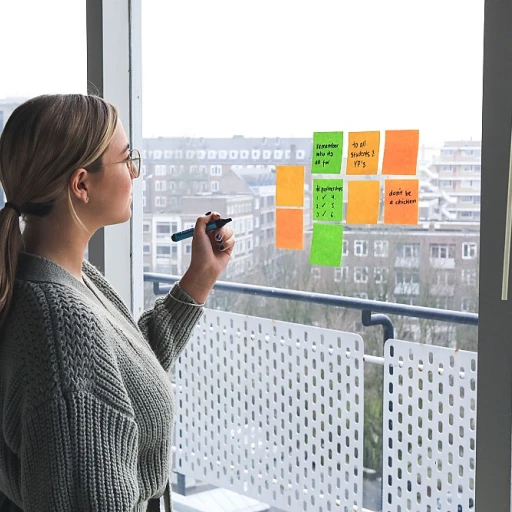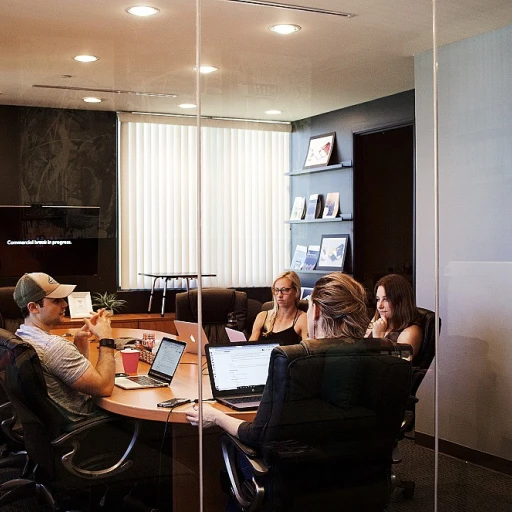
Understanding the Importance of Consensus in Change Management
The Role of Consensus in Driving Change
In the realm of change management, the decision-making process is often characterized by uncertainty and resistance. Ensuring a smooth transition necessitates collaboration and joint decision making, two elements at the heart of consensus building.
Incorporating a range of perspectives from all team members not only enriches the outcome but also garners wider acceptance within the group setting. This acceptance translates to a more committed scrum team working towards common goals, helping to streamline the process of introducing new initiatives or modifying existing ones.
Successful consensus building ensures that every team member has a say, all the while guided through structured frameworks such as agile scrum methodologies. Within agile scrum teams, roles like the scrum master and product owner play pivotal positions in mediating discussions and ultimately fostering an environment where decisions can be made quickly and comprehensively.
One key consideration when building consensus is the effective use of active listening and shared understanding across all group members. These skills can ensure that the consensus process respects every participant's input, leading to better, more inclusive outcomes. Tools such as dot voting and test questions, can help clarify choice priorities and facilitate collective decision making.
Achieving consensus is not an end in itself; it's a strategy for representative management and an essential aspect of cultivating buy-in, paving the way for effective change implementation. Understanding its importance and integrating it within your project management practices could significantly impact your team's ability to adapt and thrive.
Identifying Key Activities to Foster Consensus
Engaging in Collaborative Activities
Successful consensus building in group settings involves engaging in specific activities that promote collaboration and open communication among team members. By focusing on inclusive decision-making processes, teams can advance towards achieving their goals more effectively. Key activities for fostering consensus in project management involve clear communication and active participation from all group members.
Facilitating Structured Discussions
Structured discussions are essential in the consensus-building process. Utilizing techniques such as scrum or agile processes can help teams organize their thoughts better. Incorporating agile scrum methodologies allows team members to voice their opinions through scheduled meetings like daily stand-ups, sprint reviews, and retrospective sessions.
Encouraging Active Listening
Active listening is more than just hearing words; it's about digesting information, reflecting on it, and responding constructively. In a setting where every team member feels heard and valued, consensus building becomes smoother. Scrum masters and product owners play a crucial role here by fostering an environment where open dialogue is encouraged, and diverse perspectives are respected.
Implementing Decision-Making Tools
Decision-making tools can streamline the process of reaching consensus. For example, dot voting is a popular method used within scrum teams to prioritize user stories. Each member of the team places dots on the options they prefer, thus enabling collective input and leading towards a consensus decision. Providing such tools can significantly enhance collaborative efforts in reaching agreements.
Testing Assumptions and Ideas
Carrying out test questions based on assumed scenarios helps uncover potential roadblocks and understand group dynamics better. This approach ensures that ideas and choices are examined from various perspectives, leading to informed decision-making, ultimately improving the outcome of the consensus process.
Maintaining Flexibility
While the goal is to ensure a cohesive decision-making process, maintaining flexibility is important. As group members engage in the making process, new insights or challenges might arise. Being open to revisiting and revising decisions as needed ensures that consensus remains adaptive and relevant. This blog post on stakeholder engagement could provide additional insights on handling changes during initiatives.
Role of Leadership in Consensus Building
Guiding the Direction: Leadership's Position in Facilitating Agreement
In fostering a productive consensus, leadership plays an integral role in shaping the decision-making process by setting clear expectations and providing direction. When teams are engaged in a group setting, strong leadership can influence how ideas and perspectives are shared, and decisions are made. This is particularly essential in agile scrum environments where team members heavily rely on collaborative practices.
A scrum master or product owner can be instrumental in guiding scrum teams towards a common goal by ensuring that all voices are heard, and any conflicts are promptly addressed. By actively listening and validating contributions of all group members, leaders can foster an inclusive environment that promotes collaboration, ensuring that all angles of the project are considered before arriving at a consensus decision.
It is not just about making the right decision but engaging the entire team in the consensus building process. A study on project management indicates that team members are likely to support decisions they have helped formulate. You can learn more about overcoming barriers to change in your organization by reviewing insights from the art of overcoming resistance to change.
Moreover, effective project leaders use their ability to navigate through challenges and spend time planning proactively. Utilizing techniques like dot voting or structuring test questions for active listening can be great assets in gaining consensus. In agile environments, making better choices in the consensus process can directly enhance product delivery. With strong leadership, group agreements can become seamless and positively impactful on the project outcome, thus creating a trusted and cohesive work environment.
Overcoming Challenges in Group Consensus
Challenges and Strategies for Consensus in Group Settings
Building consensus in a group setting is not without its challenges. It's essential to recognize these hurdles early on in the change management process to ensure smooth progression. By understanding these obstacles, a team or project manager can effectively strategize to overcome them. Here are some common challenges and strategies to address them:- Diverse Opinions and Conflicting Priorities: One of the most significant challenges is the variation in opinions among group members. Each member may have different priorities, especially in a diverse scrum team aiming for agile processes. Encouraging open communication and active listening can help in understanding different perspectives. Engaging everyone in the consensus process can make all team members feel valued and considered.
- Lack of Clarity in Decision Making: Without a clear framework, teams may struggle with making solid decisions. Implementing structured methodologies like dot voting or user stories can clarify the decision-making process. These tools help in defining clear choices and drive consensus decision outcomes.
- Dominance of Certain Voices: Sometimes, more assertive members can dominate discussions, overshadowing quieter team members. A scrum master or product owner should ensure balanced participation by creating an inclusive environment. Using facilitation techniques and posing test questions can help encourage equal contribution from all group members.
- Time Constraints: Projects often have tight deadlines, which can pressure teams to rush through the decision-making process. Allocating specific time slots for discussions and ensuring that decisions are not made hastily can reduce this pressure. Agile scrum practices emphasize breaking work into manageable pieces, allowing enough time for thoughtful consensus building.
Tools and Techniques for Effective Consensus Building
Utilizing Effective Tools and Techniques
In the realm of change management, employing the right tools and techniques can significantly enhance the consensus building process. These tools help streamline decision making, ensure active collaboration, and foster better communication among team members. Here are some effective methods to consider:
- Dot Voting: This technique is a simple yet powerful way to gauge the preferences of group members. By allowing team members to vote on various options, you can quickly identify the most popular choices, facilitating a more democratic decision making process.
- Agile Scrum Practices: Scrum methodologies, such as daily stand-ups and sprint reviews, promote transparency and regular feedback. This ensures that all team members, including the scrum master and product owner, are aligned and actively participating in the consensus process.
- User Stories: By breaking down projects into user stories, teams can focus on specific tasks and outcomes. This helps in building consensus as each team member understands their role in the larger project, making collaboration more effective.
- Active Listening: Encouraging active listening within the team fosters an environment where all voices are heard. This technique not only helps in better understanding different perspectives but also in refining the final decisions made by the group.
- Test Questions: Before finalizing any decision, pose test questions to evaluate the potential outcomes. This ensures that the choices made are well thought out and align with the project’s objectives.
Implementing these tools and techniques can significantly improve the consensus decision making process, ensuring that all team members are on the same page. As discussed in earlier sections, the role of leadership and overcoming challenges are crucial, but the right tools can make the process smoother and more efficient.
Case Studies: Successful Consensus Building in Change Management
Illustrative Success Stories Demonstrating the Power of Consensus
In the dynamic environment of agile teams and change management, several organizations have excelled in utilizing consensus-building techniques to drive successful project outcomes. Here, we explore case studies that show the empowerment gained through effective consensus decision-making.- Tech Innovators Company: Enhancing Product Development through Agile Scrum - By employing agile scrum methodologies, this organization was able to improve their product development process significantly. The inclusive nature of scrum allowed for transparent decision-making where each team member, from the product owner to the scrum master, actively contributed to crafting user stories. Through activities such as dot voting and test questions, the teams reached a consensus that balanced stakeholder needs with innovative ideas. This collaborative approach ensured better outcomes and faster market launches.
- Financial Services Firm: Building Consensus for Strategic Decisions - This firm faced challenges in aligning various departments when making strategic decisions. By integrating consensus-building workshops into their project management routine, they facilitated active listening among group members. Such sessions empowered team members to express their views, which were crucial in identifying potential obstacles. The outcome was a unified vision, reinforcing commitment from all team members to the agreed strategies, leading to enhanced performance and strategic clarity.
- Healthcare Sector: Overhauling Operational Processes - Within their operational overhauls, one healthcare organization successfully utilized consensus-building techniques to unite diverse teams. By valuing each team member's input and prioritizing their consensus process, they not only improved collaboration but also increased satisfaction with the changes being implemented. This approach proved instrumental in executing process changes that were well-received across all levels of the organization.













